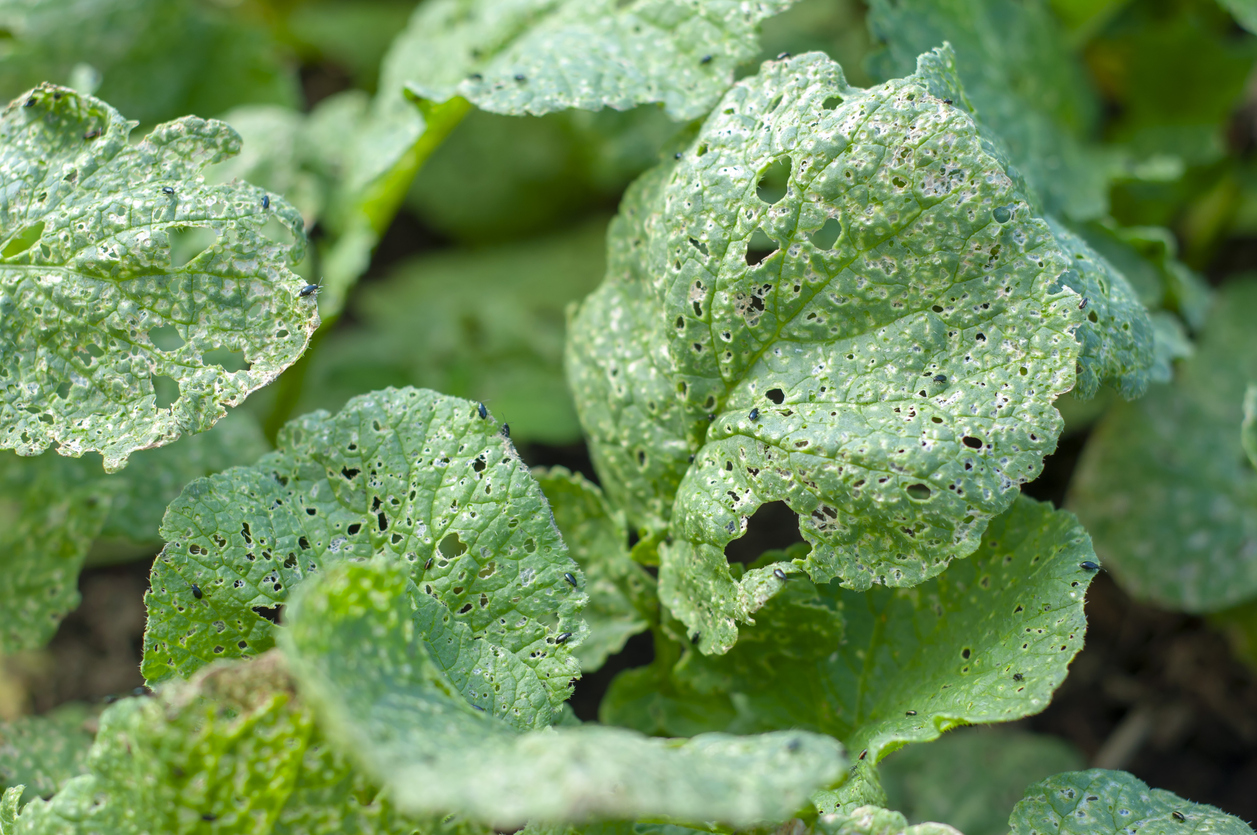
Radish plant leaves damaged by pests
Pests on your radishes, left unchecked, can damage and destroy your developing plants. Keeping a close watch on your plants during regular daily inspections will help you spot any pests before they can do irreparable harm. Healthy radishes can bounce back from pest damage if you catch the pests quickly.
A couple notes about prevention:
- Don’t overwater.
- Use floating row covers when plants are young.
- Place sticky traps to catch pests early.
- Plant trap crops like marigolds that will attract pests away from your plants.
Spot the symptoms of radish pests
Check leaves and bulbs for these symptoms that come from pests on the prowl.
On Radish Leaves
| Symptoms | Pest |
|---|---|
| Yellowing leaves; clusters of small “bumps” on leaves | Aphids |
| Tiny irregular holes in leaves | Flea beetles |
| Heavily chewed leaves; defoliation | Cutworms |
| Chewed underside of leaves, and since they are voracious eaters, will likely see the light green worms with white stripes on the plant | Cabbage loopers |
On Radish Bulbs
| Symptoms | Pest |
|---|---|
| Bite wounds and tunnels through bulb and stems that allow disease to enter | Cabbage maggots |
| Sucks on the plant’s juices and will leave white spots on bulb, and then leaves will be brown and wilting | Harlequin bugs |
How to treat pests on radishes
First be careful not to use broad-spectrum insecticides, because they can kill off natural predators of the above pests. Here are some proven ways to get rid of pests on your radishes. Choose the best treatment for the type of pests invading your plants.
- Shake the plants. Bigger pests can be spotted with a little shaking. For example, cabbage loopers are hard to spot because they blend in with the leaves, but a little shake and they’ll disperse, giving you time to apply a neem oil solution that will prevent them from coming back.
- Pick off the bigger pests. Use your garden gloves to remove the pests by hand. After removal, destroy pests by drowning them in a bucket of soapy water or crushing them with your foot. Handpicking isn’t efficient or practical for very small pests but works well with larger pests like cutworms and cabbage maggots.
- Wipe the underside of the leaves if you see eggs. Insects can lay a tremendous number of eggs in a short time, so you’ll want to wipe down the underside of the leaves if you see eggs.
- Blast them. If you spot invaders like aphids, give them a good blast with the garden hose. Chances are good the neighborhood birds will notice and come eat your pests. If you have insects on the undersides of your leaves, misting that area will attract beneficial predators.
- Apply insecticidal soap. Insecticidal soap is organic. The potassium salts in insecticidal soap help remove an insect’s protective waxes, causing destruction of insect membranes and killing them. Mix the soap with water to create your solution and apply directly to insects on any plants. While insecticidal soap is less apt to affect other organisms, certain plants might be sensitive to the soap and can suffer leaf burn.
- Apply horticultural oils. Combine plant- or petroleum-based oils with water to produce horticultural sprays. Neem oil, for instance, is derived from seed extracts of the neem plant. Oil-based sprays block an insect’s air holes, interfere with an insect’s metabolism, disrupt insect feeding, and inhibit insect growth. Like insecticidal soaps, horticultural oils can cause plant injury if not properly diluted.
- Make your own pest spray. You can make your own pest spray with benign materials. Mix 1 tablespoon of baking soda, 1/2 teaspoon of a mild dish detergent, and 2 1/2 tablespoons of olive oil in a gallon of water to make a solution that will repel all kinds of bugs, as well as a fungicide for blight and mildew on plant leaves. Shake it well in your bottle before spraying and repeat every week for it to be continuously effective.
- Diatomaceous Earth (DE). Sprinkle DE at the base of plants and between plants. Many pests cannot cross over this barrier without dying because it dries out their protective shells.
- Soil solarization. Since some pests live in the soil, along with many soil infections, it’s wise to solarize your soil by covering it with a clear tarp in the middle of the summer if an infestation does arise. Nematodes can live in your soil indefinitely until they are eradicated.
Do pests attack your radishes every year? How do you handle removing them—and even preventing them in the first place? Please tell us how you treat your radishes to avoid pests.


 Previous
Previous

